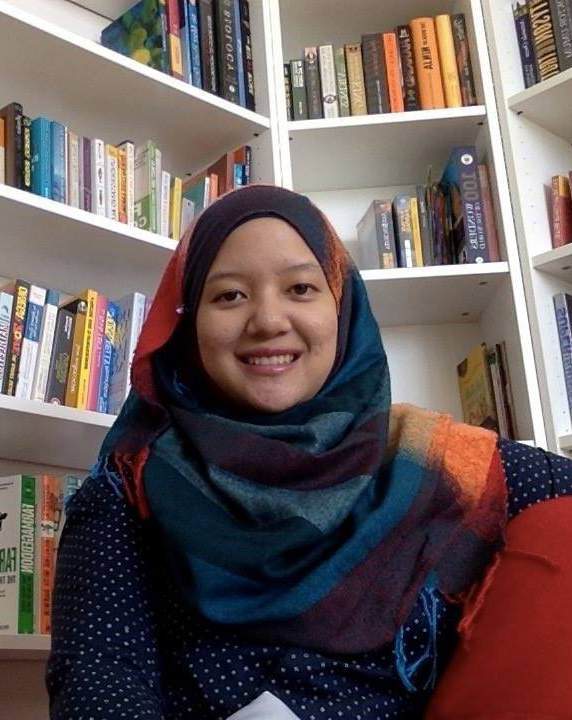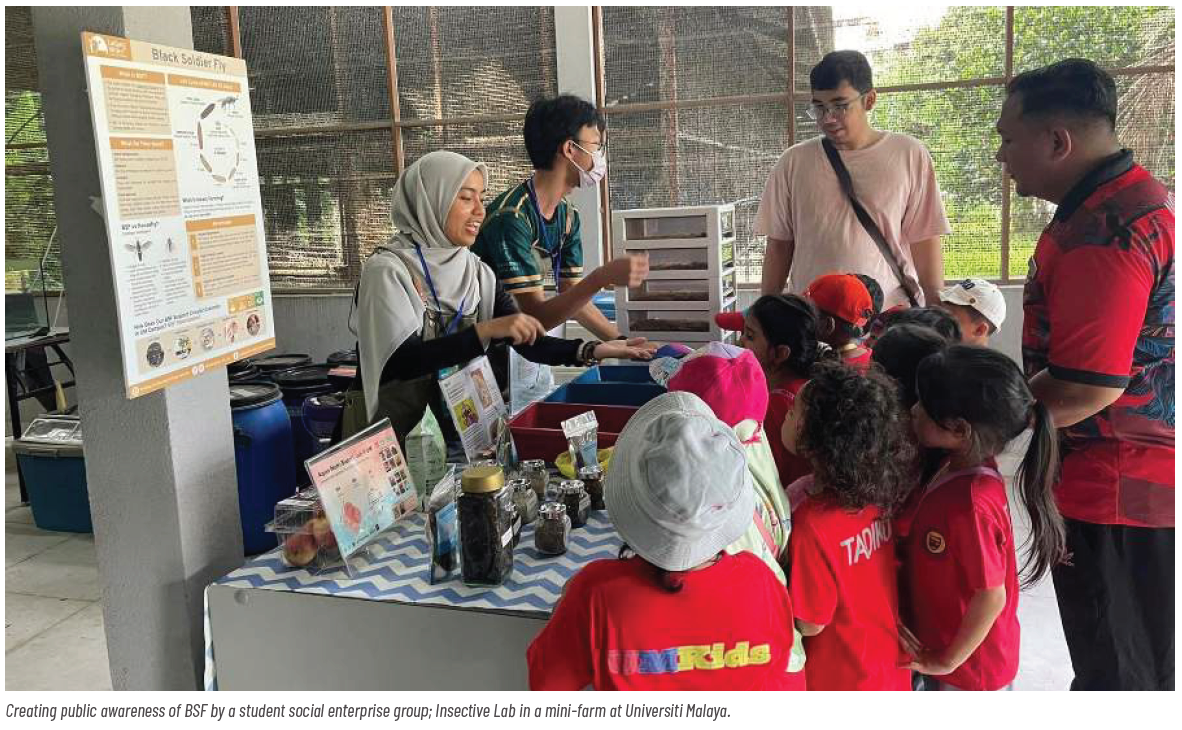Industry Profile: DR NORHIDAYAH MOHD TAUFEK

DR NORHIDAYAH MOHD TAUFEK
The larvae of BSF have been known to efficiently break down organic waste and create valuable by-products like frass from BSF excrement for use as organic fertiliser. It has been interesting to see the growing number of BSF companies in Malaysia utilising agri-byproducts, particularly from palm oil waste, to produce the insect frass. It has been reported that this fertiliser is perfectly suited for commercialised Malaysian-produced crops such as durian, pineapple, and also palm oil, where the substrates for the BSF came from.
Furthermore, the Malaysian government is also beginning to recognise the potential of BSF compared to a decade ago. Since the sector is still new, numerous incentives are being offered to encourage research and development, with the hope of increasing productivity and fostering the sector’s growth.
Q: In many parts of the world, black soldier fly larvae (BSFL) have been useful in helping to solve the food waste crisis by converting organic wastes to protein and fertiliser, helping animals and crops to grow and putting food on the table. But how does this process work in countries which do not have clear waste separation policies and infrastructure to ensure that the flies have access to only organic wastes?
A: In countries like Malaysia, most companies rely on single agribyproducts, particularly from palm oil waste, to feed the BSFL. Waste such as decanter cake and palm kernel expeller (PKE) are commonly used in the BSFL industry due to their abundance, which would solve the indiscriminate disposal of this waste in the palm oil industry. Many largescale BSFL producers choose to use a single source of waste substrate to improve the quality and standardise the nutrient profile of the larvae, hence avoiding the need to separate waste.
Most BSFL bioconversions using food waste as a substrate are carried out by small-scale producers. They rely on organic waste from businesses and domestic sources for their BSFL production, and most of the time, the sorting and processing of the waste will be done manually in their facility. Typically, this practice is helpful for managing waste and producing BSFL value-added products like fertiliser that pose less safety risks. However, it is best to have clear guidelines on the type of organic waste that is safe for BSFL production.
Q: What are some initiatives in Asia which have been successful in valorising the larvae of black soldier fly for aquafeeds?
A: In comparison to a decade ago, I can see increasing initiatives from private entities and the government in the alternative protein industry today. Leading the headlines is the BSFL industry, which is dominated by Malaysia (in this region) in terms of production capacity. However, BSFLbased aquafeed is still in its infancy as a commercial product. It has yet to be adopted by existing large feed manufacturers, mostly because the insect industry is still fairly new. Cost and volume are the concerns in the industry compared to existing plant and animal protein meal.
On the other hand, there are increasing alternatives from small-label manufacturers providing competitive, sustainable aquafeed that utilise BSFL meal as a main protein source in their formulation. In Malaysia, some smallholder farmers produce BSFL for their own farm consumption due to its availability and reasonable cost.

A: BSFL offers a healthy and promising substitute by decreasing feed cost and reliance on imported fishmeal. Research on aquatic organisms has shown that there are varying concentrations of BSFL that can be used as a substitute for fishmeal without negatively impacting the development of the fish.
While specific data on Malaysian fish growth rate improvements with BSFL might be limited, the trend is positive. Our laboratory research has found that red hybrid tilapia were able to have half of their fishmeal (or 15% of their total diet) replaced with BSFL. Recently, we published a paper on jade perch, which was found to accept the same inclusion level of BSFL-based diet as the red tilapia.
In the Asian context, a new development out of India has shown that pangasius catfish can have their growth and nutrient utilisation unaffected by completely substituting fishmeal for fermented BSFL meal. Meanwhile, for Pacific white shrimp, the best diet for optimal growth was found to one where the inclusion level of BSFL did not exceed 20%.
Q: Apart from black soldier fly, are there any other species of insect which might be considered as a partial replacement for fishmeal in Asian aquafeeds?
A: Research on Asian aquafeeds has shown that various insects might be a sustainable and healthy alternative to fishmeal. Aside from black soldier flies, there are several insect species that are becoming more popular among researchers as alternatives to fishmeal compared to a decade ago. Among these are mealworms, silkworms, superworms, species of flies, crickets and grasshoppers.
Field crickets, or Gryllus bimaculatus (which is also part of my research), is a widely available species in Asia. It has been known to improve African catfish and tilapia growth, digestibility, and resistance to oxidative stress.
Sustainable aquafeed manufacturers in Asia may look to these other insect species in the future, even though BSFL is now at the forefront. To tap into their potential in aquaculture, further research into their nutritional profiles, processing methods, and compatibility with fish species is essential.
Q: Do you foresee a day when BSFL might be a source of protein for human consumption?
A: BSFL is now used mostly for animal feed, fertiliser, and waste management because of its great nutritional value for animals and its role in the circular economy. While many people in various parts of Asia, South America, and Africa have grown accustomed to eating insects like grasshoppers, mealworms, palm weevils, and crickets, BSF is not one of those species. The European Union and, more recently, Singapore, have both legalised the consumption of some insects as a human food source, but BSF is not yet on the list.
Safety concerns, especially regarding the substrates and culture systems used, are among the many reasons BSF is not regarded as human food. Not many studies have focused on BSF as a potential food source for humans, and public perception of insects as a food source is still relatively low. Nevertheless, as time goes on and more people start to see insects as a food source, I think BSF will also get its due recognition.
Q: Leading companies involved in the BSFL industry have invested in smart (IT) breeding and farming practices. But is it technologically and financially feasible for BSFL to be reared, processed and marketed at the small-scale aquaculture level? What kind of training and financial resources would be required?
A: In Malaysia, anyone can start producing BSFL due to our favourable climate and low starting costs. However, we do not want people to rush into it without considering safety concerns. As a matter of personal responsibility, everyone interested in entering the industry should educate themselves on responsibly cultivating BSFL to preserve the ecosystem. Nevertheless, we still need a Malaysian-specific regulatory framework as a road map for the industrial sector. Although no established blueprint exists, several government agencies and universities offer preliminary training to attract interested parties and raise awareness of the BSFL industry. Those who are interested can take advantage of the training that is now accessible. However, proper financial incentives from the government will definitely help to accelerate the adoption of sustainable alternative protein to support our Blue Transformation framework.

Q: And ending on a general question, how should universities and research institutes work with both the public and private sector to create an enabling environment for insect protein technology within the framework of Blue Transformation?
A: We acknowledge that insect meal isn’t explicitly included in the Blue Transformation framework. Still, there is concern about using fishmeal as a feed ingredient and finding a strategy to obtain alternative protein sources as a replacement. As aquaculture nutritionist researchers, we are open to working with other agencies to accelerate this innovation.
I believe that we should engage in more public outreach and dialogue with all relevant sectors regarding this matter. Over the last decade, we have seen a lot of progress, but we need to have more conversations to stay on the same page. The insect as food and feed movement is still in its early stages, but researchers and industries are already collaborating to achieve our aims.
With close cooperation between academic institutions, industries, communities and government bodies, insect protein technology could revolutionise agriculture across Asia, particularly Malaysia. As the universities provide cutting-edge research, the industries could translate this knowledge into viable products, and the government’s involvement through supportive policies and regulations can then create a stable and attractive environment for investment.






























